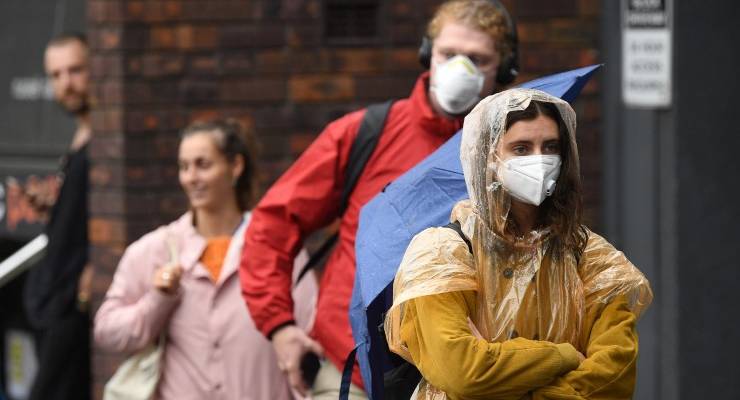
Brendan Murphy has expressed optimism that Australians will continue to flatten the curve if social distancing rules are observed, particularly this Easter weekend. The latest coronavirus statistics may help us to answer two popular questions that we find ourselves asking this week.
- Are we actually flattening the curve?
- When will coronavirus lockdown end?
Are we flattening the curve?
While the number of cases of COVID-19 continues to grow across Australia, the rate of growth has slowed.
Here are the coronavirus statistics you need to know right now. (These statistics will be updated on a daily basis to keep you informed.)
- There are 7,079 confirmed coronavirus cases across Australia
- 6,444 people have recovered from the virus to date
- The current death toll of coronavirus is 100
Social distancing updates
- New South Wales
- Victoria
- Queensland
- Western Australia
- Tasmania
- South Australia
- Northern Territory
- Australian Capital Territory
When will the coronavirus lockdown end?
How long will the coronavirus lockdown last in Australia? It’s the question at the back of all of our minds.
Here’s what we know:
- The coronavirus lockdown may last for an average of 10 weeks, based on the only real example we have: Wuhan, China
- To date, China is the only country that has taken hold of the rapidly rising number of COVID-19 cases in its population, with lockdown restrictions now being lifted and life reportedly returning to normal
- Thirty-one provinces across China have been affected by coronavirus, with lockdowns ranging from four to 10 weeks.
According to the federal government, there is a two-part formula for predicting a potential reduction in COVID-19 cases:
- On average, it takes approximately seven days to see a change in the daily number of coronavirus cases. The seven-day period starts from day one of each individual correctly self-isolating
- Those who are carrying the virus but are nonsymptomatic require an extended period of time between recognising their symptoms, to getting tested and receiving their results. For individuals who are critically unwell, it takes approximately 11 days between diagnosis and treatment to see a potential daily reduction in coronavirus cases.
The spread of the coronavirus is slowing across Australia, and this is largely due to the travel restrictions and closure of non-essential business implemented by the federal and state governments.
An end to the lockdowns will largely depend on Australians following guidelines as put forward by medical professionals and governments. While cases of COVID-19 may be slowing right now, there is concern around the possibility of local transmission, and public non-adherence to social distancing rules.
The latest coronavirus statistics as cited above will determine when lockdown will end; if they continue to lower, life may slowly return to normal and lockdown restrictions may loosen. New South Wales Police Commissioner Mick Fuller says current enforcement laws are set to expire this coming June, and as it stands, he will not seek to expand them. Health Minister Greg Hunt has reportedly said the lockdown, or some restrictions that are currently in place, could stand for at least six months.
With the majority of Australian states now in stage three lockdowns this week, it is only natural we are asking ourselves questions, such as:
- When will I be able to return to work?
- When will restaurants, bars and hairdressers open once again?
- When can I go to the supermarket without worry?
When will Australia’s coronavirus lockdown end? At this point, the answer is not clear. It took 10 weeks for the epicentre of the virus to reportedly recover, and that may be the number we need to use to manage our expectations.








Ten weeks from when for Australia? This article is not very helpful as it doesn’t give what is considered to be our official start date, although from the chart it appears to be the beginning of March. Ten weeks would put us roughly at mid May, in a week’s time, which seems unlikely.
Lockdown will end if the All Ords drifts the wrong side of 5000.
The real question is since when is it rational to lock up millions of totally healthy people and on what basis was it done. The answer is a ”model” done by Neil Ferguson in the Bill Gates and vaccine companies funded ”unit” at Oxford imperial that was dismissed in the UK BEFORE it was reported here in the NINE papers. His model ”predicted” 540,000 deaths in the Uk and 2.2 million in the USA. Paul Kelly here extroplated that would mean up to 150,000 deaths in Australia and good old Norman Swan at the ABC was only too happy to help peddle it.
Trouble is Neil Ferguson has been wrong on every case he has “”modelled” , they are all based on Spanish flu which has no bearing on anything.
On March 19 the experienced health officials rightly downgraded this corona to the same level of all the other coronas and were right to do so. Then the UK parliament decreed that all deaths in care homes and hospitals had to be listed as covid 19 even if they never saw a doctor, were never tested and were declared by untrained staff. So the death toll in the UK is probably actually about 10% of the reported number.
I don’t want to argue about numbers but the biological fact is that lockdown reduces to the number of potential hosts available to the virus. Look at places like Iran that did not lock down soon enough. The virus will not stop looking for hosts after lockdown, it’s just at a more controllable level. The danger is that many people think the all-clear has been sounded and they can abandon social distancing.
So, we have some real figures now on what happens when you do not take action to stop the epidemic. This is not modelling or anything based on Spanish flu. Just take a look at the numbers of deaths in the US, UK, Spain, Italy and other countries that were slow to react.
If we had been as slow as those countries we’d be looking at tens of thousands of deaths rather than one hundred. No modelling. no Bill Gates. or whoever your favourite conspiracy theory tells you is responsible, just actual numbers of real people dying.